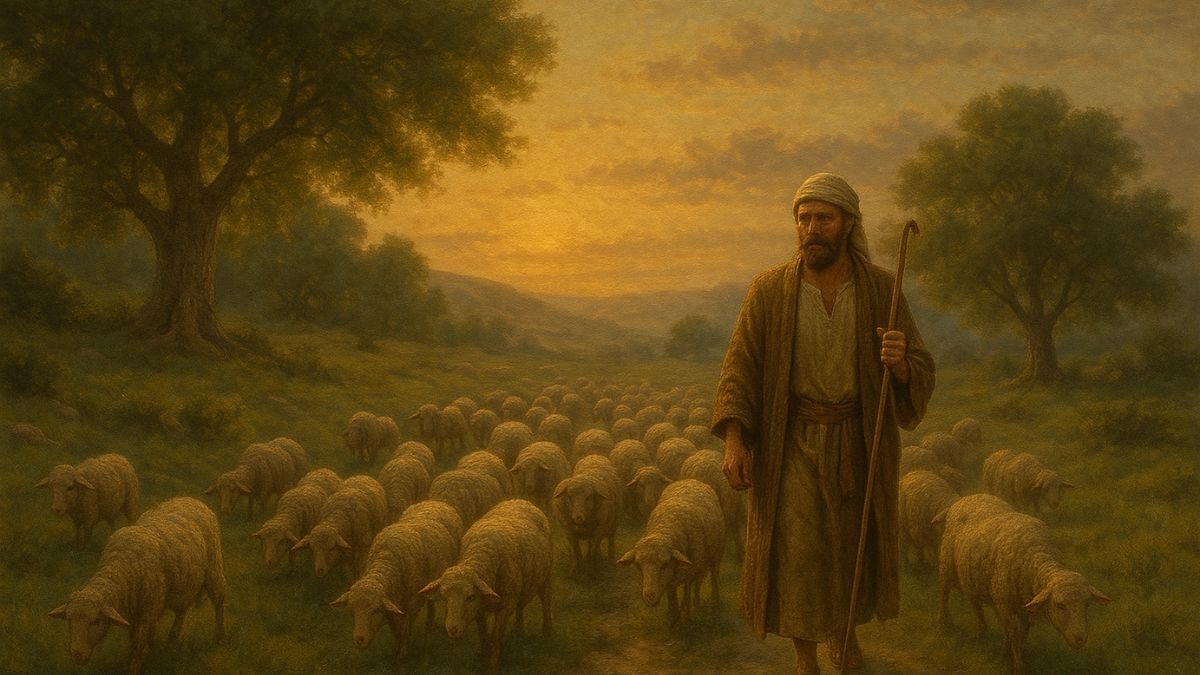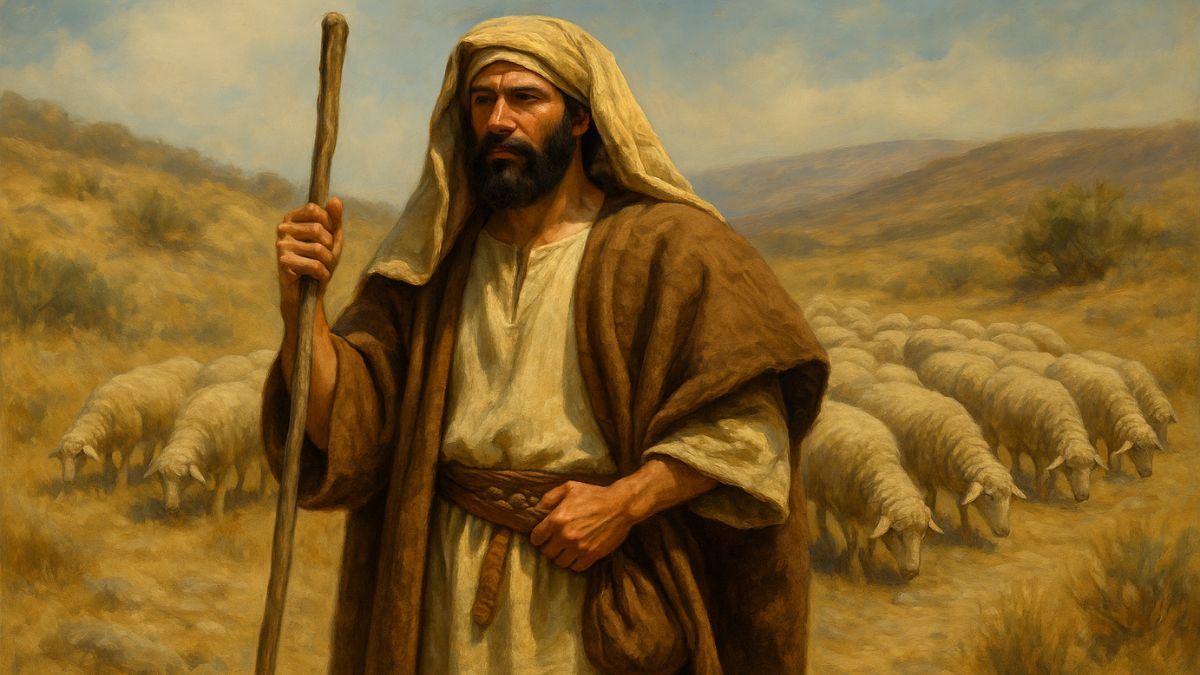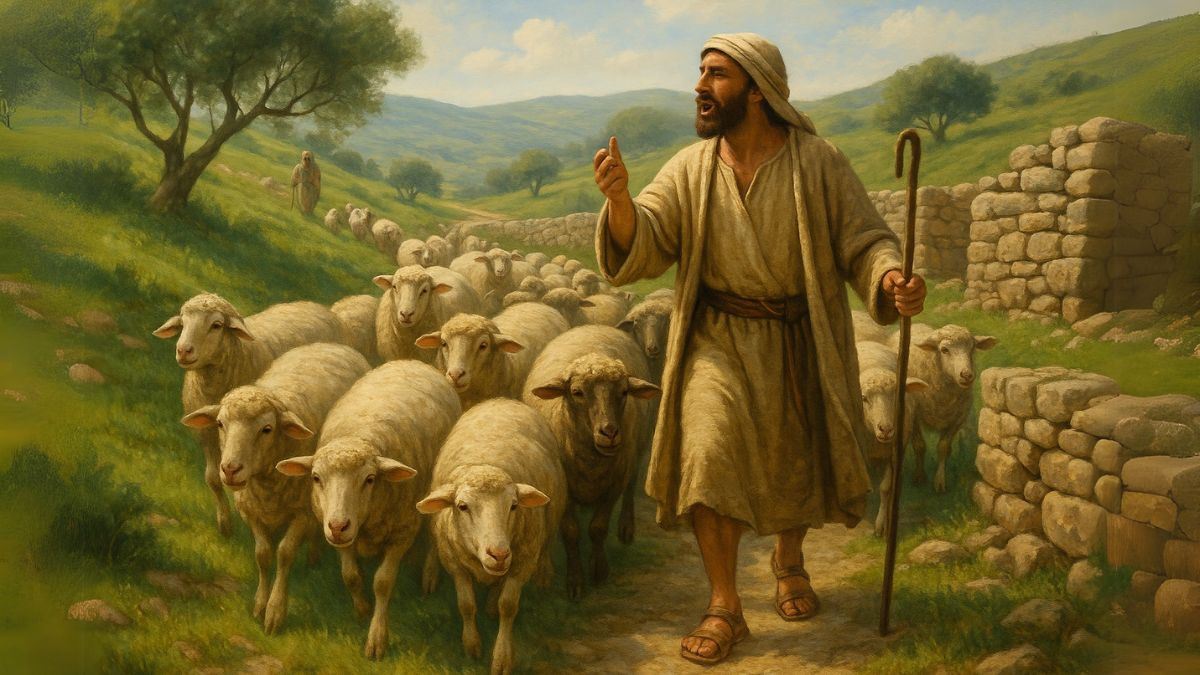The Importance of Shepherding in the Biblical World
In the ancient landscapes of the Middle East, where the Bible's narratives unfolded, shepherding wasn't merely an occupation - it was a cornerstone of society, economy, and cultural identity. The rolling hills of Judea and Galilee, the fertile plains near water sources, and even the harsh wilderness areas all witnessed the daily movements of shepherds guiding their flocks in search of sustenance.

The economic foundation of biblical societies was deeply rooted in shepherding for several critical reasons:
- Sheep and goats provided multiple essential resources: wool for clothing, milk for daily nourishment, meat for special occasions, and hides for various implements
- A household's wealth was often measured by the size of its flocks
- Major transactions might be conducted using sheep as currency
- Sheep products formed the basis of regional trade networks
- Shepherding allowed utilization of marginal lands unsuitable for agriculture
This economic reality explains why figures like Abraham and Jacob, whose prosperity was measured partly by their abundant livestock, were considered wealthy and influential in their day.
Social Status of Shepherds in Biblical Times
The social position of shepherds throughout biblical history presents a fascinating paradox. While the occupation was economically essential, shepherds themselves often occupied a marginal position in society. Despite this marginalization, shepherds maintained their own social hierarchies and specialized knowledge. Master shepherds directed less experienced workers, with specific roles assigned based on skill and experience.
The occupation required remarkable knowledge of animal behavior, landscape, weather patterns, and resource management - expertise that was respected even when the social status of shepherds in biblical times remained low. Paradoxically, despite this complex social position, the shepherd remained a powerful positive symbol in religious and political contexts, representing ideal leadership and divine care throughout Israel's history.
Daily Life of a Shepherd in Biblical Times
Daily and Nightly Routine
The life of a shepherd in biblical times followed the rhythm of nature rather than the clock. Rising before dawn, shepherds would lead their flocks from the sheepfold to fresh grazing lands, carefully selecting routes that offered both nourishment and safety. Unlike modern ranching, biblical shepherding involved actively leading - not driving - the sheep, with the shepherd walking ahead and the flock following his familiar voice.
Daytime hours were spent guiding the sheep to grass and water while vigilantly scanning for dangers. During the hottest midday hours, shepherds would often lead their flocks to shaded areas for rest. As evening approached, they would begin the careful journey back to the safety of the sheepfold or night encampment.
Nighttime brought different challenges. Shepherds often worked in shifts, maintaining watch throughout the dark hours to protect against predators and thieves.
Living Arrangements and Shelter
Shepherds employed various sheltering strategies depending on the season and location:
- Natural caves provided excellent shelter during poor weather
- Simple lean - tos constructed of branches and animal skins offered portable protection
- Stone enclosures (sheepfolds) with narrow entrances protected the flock at night
- Watchtowers allowed shepherds to monitor larger areas during daylight hours
During extended periods away from settlements, shepherds lived minimally, carrying only essential supplies and relying on the land for supplemental resources. In more established grazing territories, semi - permanent structures might be maintained by shepherding communities, with different families rotating their use throughout the seasons.
Nutrition and Water Supply in Field Conditions
The shepherd's diet was remarkably simple yet sufficient for their active lifestyle:
Bread formed the foundation of their nutrition, often prepared as flat cakes baked on heated stones. This was typically complemented with cheese and curds from their flock's milk, dried fruits when available, and occasionally wild honey. Meat was rarely consumed except during festivals or when an animal needed to be culled.
Water management represented one of the shepherd's greatest challenges. Knowledge of reliable springs, seasonal streams, and hidden water sources was carefully guarded and passed down through generations. Shepherds often carried waterskins for personal use, while larger water holes served the flock. The biblical emphasis on "still waters" in Psalm 23 reflects the shepherd's understanding that calm water was safer for sheep, who could easily drown in fast - moving currents.
Challenges and Dangers of a Shepherd's Life
The biblical shepherd faced numerous threats that required constant vigilance:
- Predators: Lions, bears, and wolves posed serious dangers to both flock and shepherd
- Bandits and raiders who targeted vulnerable shepherds in remote areas
- Sudden flash floods in desert wadis that could sweep away animals and humans
- Extreme temperature variations between scorching days and freezing nights
- Poisonous plants and snakes that threatened both shepherd and flock
These dangers contextualize David's courage when he recalls defending his sheep against lions and bears (1 Samuel 17:34 - 36), highlighting the physical bravery required of even young shepherds.
Clothing and Equipment of Shepherds in Biblical Times
Traditional Clothing of Shepherds
The attire of biblical shepherds balanced practicality with the limited resources available to these often humble workers. Archaeological findings, biblical references, and regional traditions suggest a distinctive yet simple wardrobe:
The foundation of a shepherd's clothing was the tunic (kethoneth in Hebrew) - a simple, knee - length garment woven from wool or occasionally linen for those who could afford it. This was typically belted at the waist with a cloth or leather girdle, which served the dual purpose of securing the tunic and providing a place to carry small items like a knife, sling stones, or a small pouch.

Over this, particularly for cooler weather or nighttime watches, the shepherd would wear a heavier outer garment called a simlah - a rectangular cloth that served as a coat by day and a blanket by night. This multi - purpose garment was so essential that biblical law required it be returned before nightfall if taken as collateral for a loan (Exodus 22:26 - 27).
Footwear consisted of simple leather sandals, though many shepherds, especially children and those in poorer circumstances, often went barefoot during warmer months. Headwear was critical in the Middle Eastern climate, with most shepherds wearing cloths draped over the head and neck for protection from the intense sun.
Protection Against Weather Elements
The extreme climate variations of the biblical landscape required shepherds to adapt their clothing and practices seasonally:
Summer Challenges:
- Temperatures frequently exceeding 100°F (38°C)
- Intense solar radiation on exposed hillsides
- Limited shade and water sources
- Dust and dry conditions affecting visibility and breathing
During these months, shepherds relied on lightweight, loose - fitting garments in light colors to reflect heat. Head coverings became essential, often dampened with water when available to provide cooling through evaporation.
Winter Adaptations:
Cold temperatures, particularly at night and in higher elevations
Potential for snow and freezing conditions in highland regions
Cold rain and wind creating dangerous hypothermia conditions
Muddy terrain complicating travel
Winter required layering techniques, with additional animal skins or woven wool garments providing crucial insulation. The simlah's importance increased, sometimes supplemented with animal - skin cloaks among shepherds who could afford them. Shelter identification became a critical skill, with shepherds knowing every cave and protected hollow in their grazing territories.
The Shepherd's Staff - Types and Uses
Perhaps the most iconic tool of the biblical shepherd was the staff, which came in several specialized forms:
The long staff (shebet) typically reached the shepherd's shoulder height and featured a curved end. This multi - purpose implement served as:
- A walking aid when traversing difficult terrain
- A defense weapon against predators and thieves
- A guidance tool to direct sheep without touching them
- A hook to rescue animals trapped in thickets or crevices
- A checking instrument to count sheep passing "under the rod"
Some shepherds also carried a shorter rod (matteh) used primarily for protection and discipline. The biblical reference to "your rod and your staff, they comfort me" (Psalm 23:4) acknowledges both these tools as sources of security - the rod representing protection from dangers, while the staff provided guidance and rescue capability.
The Sling - Techniques of Use and Flock Protection
Beyond the iconic staff, the shepherd's sling (qela) represents one of the most versatile and lethal tools in their arsenal. Far more than a child's toy, the shepherd's sling was:
- Crafted from durable materials - typically wool, leather, or woven plant fibers
- Designed with a cradle for the stone and two long cords for swinging
- Capable of launching projectiles at speeds exceeding 60 mph
- Accurate in skilled hands at distances up to 150 yards
- Lethal enough to bring down predators like wolves or jackals
The famous encounter between David and Goliath (1 Samuel 17) makes more sense when understood in the context of shepherding - David wasn't simply lucky but rather highly skilled in a weapon he had used countless times to protect his flock from predators.
Shepherds practiced with their slings from childhood, collecting smooth stones from stream beds that offered the ideal weight and aerodynamics for accurate flight. The constant carrying of the sling, often wrapped around the head or waist when not in use, became so characteristic that it served as an identifying feature of shepherds throughout the ancient Near East.
Musical Instruments of Shepherds
The solitary nature and long hours of shepherding fostered a rich musical tradition that served both practical and entertainment purposes:
The shepherd's flute (halil), typically crafted from reed, bone, or wood, produced melodies that:
- Calmed and reassured the flock, particularly during storms or unfamiliar terrain
- Provided entertainment during long watches
- Communicated with distant shepherds through recognizable tunes
- Established the rhythm of walking for the flock on long journeys
The simple harp or lyre (kinnor) was less common but clearly associated with shepherding in biblical narratives. David's skill with this instrument highlights the musical tradition among shepherds, eventually bringing him to King Saul's court (1 Samuel 16:14 - 23).
These musical traditions influenced Israel's worship practices, with the metaphor of God as shepherd naturally incorporating the calming music associated with capable shepherds leading their flocks.
Ancient Shepherding Techniques
Managing and Directing the Flock
The biblical shepherd employed sophisticated techniques to manage their flocks, developed over generations of careful observation and practice. Unlike modern methods that often drive sheep from behind, ancient shepherds led their flocks, walking ahead and calling the sheep to follow.

Shepherds developed intimate knowledge of each animal's behavior, often naming individual sheep based on distinctive physical characteristics or personalities. This individual attention allowed them to quickly identify when an animal was sick, injured, or missing from the group. Experienced shepherds could manage flocks of 100 or more sheep, recognizing each one individually - a feat modern researchers have confirmed is possible due to the distinctive facial features of sheep.
When directing sheep through narrow passages or counting them into enclosures, shepherds would position themselves at control points, using their staff to guide each animal safely. In larger operations, multiple shepherds worked together, with clear hierarchy and assigned responsibilities based on experience and skill.
Identifying Quality Grazing Lands and Water Sources
Finding sufficient grazing and water represented the shepherd's most crucial daily challenge. Experienced shepherds developed remarkable environmental literacy, reading subtle landscape cues invisible to untrained observers.
Quality grazing assessment involved evaluating various factors:
- Grass height and density
- Presence of toxic plants
- Proximity to shelter
- Defensibility against predators
- Accessibility for young or weak animals
The best shepherds planned grazing routes that would provide progressive access to resources throughout the day, ending near water sources before the journey back to nighttime shelter.
Water source knowledge was closely guarded and often passed down through families. Shepherds distinguished between reliable year - round springs, seasonal streams, and temporary rainwater catchments. They understood which sources might be contaminated by mineral deposits harmful to sheep and which provided the clean, "still waters" ideal for their flocks. During droughts, knowledge of hidden water sources could mean the difference between survival and devastation.
Experience Shepherd Life at Kfar Kedem
At Kfar Kedem ("Ancient Village"), visitors can step back in time and experience the life of a biblical shepherd firsthand. This immersive experience offers a unique opportunity to connect with one of the most foundational occupations of the ancient world.
What to Expect During Your Visit
When you arrive at Kfar Kedem, you'll be welcomed by guides dressed in traditional biblical attire who will introduce you to the ancient art of shepherding. You'll begin by learning how to approach and communicate with the sheep, understanding their behavior and needs just as shepherds did thousands of years ago.
The "Shepherd for a Day" experience includes:
- Dressing in authentic biblical - style clothing
- Learning to use a shepherd's staff and other traditional tools
- Guiding sheep through pastures using ancient techniques
- Experiencing the challenges of finding water and suitable grazing lands
- Understanding the crucial bond between shepherd and flock
For those seeking a deeper understanding, extended experiences allow participants to experience the evening watch, learning how shepherds protected their flocks during vulnerable nighttime hours.